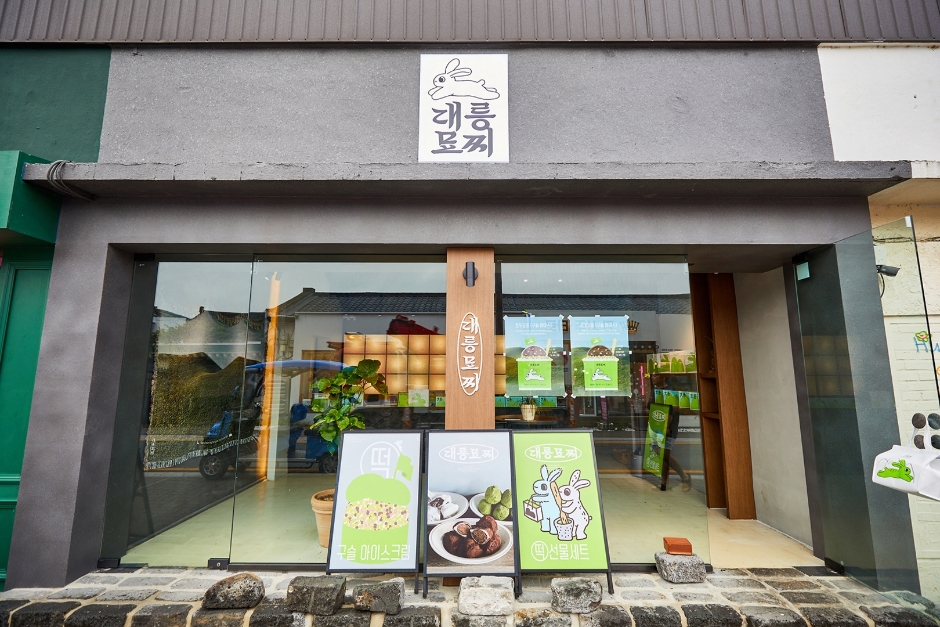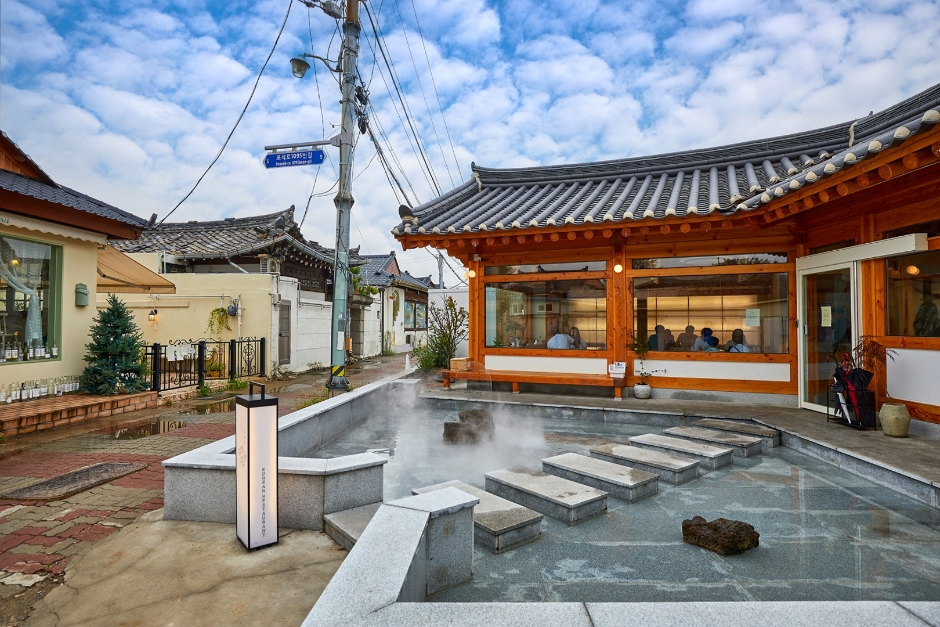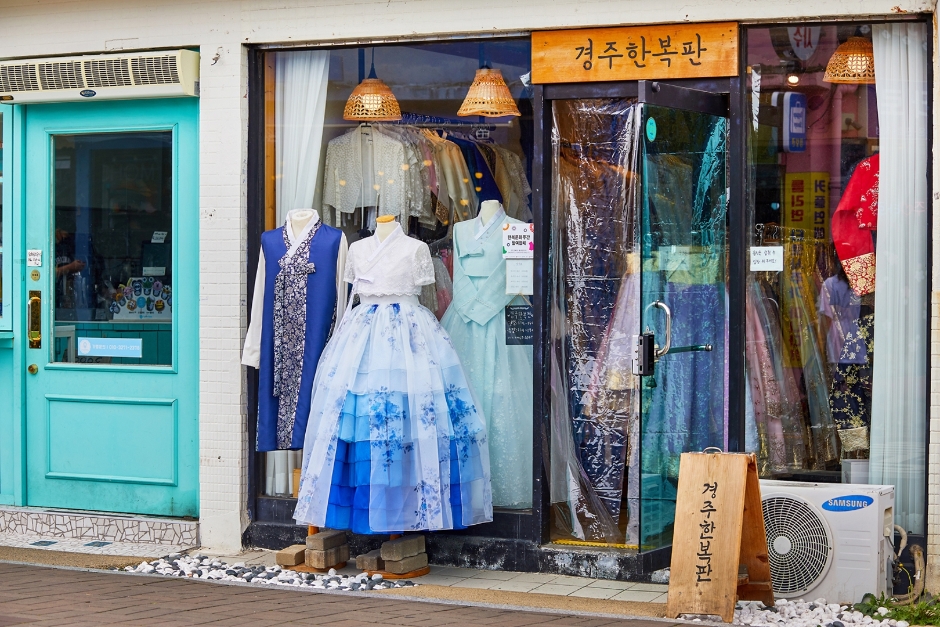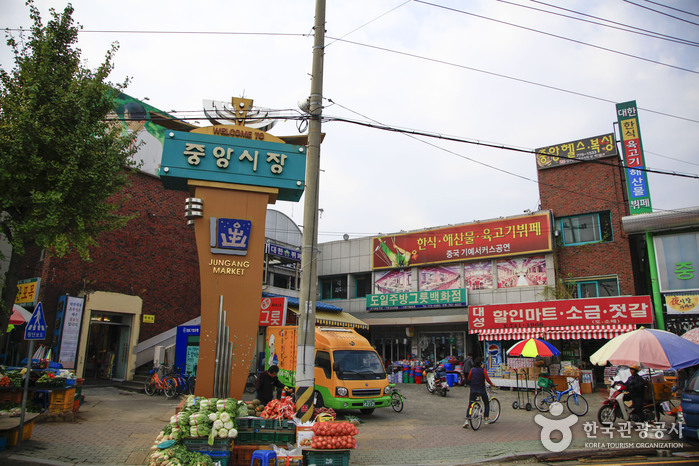Ipungnyeo Guro Ssambap (이풍녀구로쌈밥)
659.1829005625216m 42147 2024-02-23
155 Cheomseong-ro, Gyeongju-si, Gyeongsangbuk-do
054-749-0600
Near the Cheomseongdae Observatory in Gyeongju, Ipungnyeo Guro Ssambap is renowned for its signature dish, Guro ssambap (leaf wraps and rice set menu). The dish is accompanied by jeyuk bokkeum (spicy stir-fried pork) and doenjang jjigae (soybean paste jjigae), along with a diverse array of side dishes and ten different types of vegetables for wraps. The restaurant focuses on preserving the natural flavors of the ingredients, using minimal chemical seasonings. Its commitment to providing a hearty and wholesome meal attracts numerous visitors.
Daereungmyojji (대릉묘찌)
674.2241128625204m 0 2024-04-08
1085 Poseok-ro, Gyeongju-si, Gyeongsangbuk-do
Try the unique combination of beaded ice cream and sweet rice cake, a traditional Korean dessert, at Daereungmyojji on Hwangridan Street near Daereungwon Ancient Tombs. The business offers take-out only, and there are no seats. Three menus are available: mugwort flavor sweet rice cake with pea filling, chocolate flavor sweet rice cake with filling made with Belgian dark chocolate, and sweet rice cake with red bean filling and crispy walnuts. Each serving of sweet rice cakes is cut into three or four pieces and served in a cup. In addition to being a unique dessert, the packaging has a cute rabbit drawing on it. The gift set contains eight pieces, perfect for people who want to enjoy a lot of desserts.
Sugyeongsa (수경사)
689.4431872721117m 0 2024-04-08
25 Sajeong-ro 57beon-gil, Gyeongju-si, Gyeongsangbuk-do
Sugyeongsa is a fusion Korean food restaurant renovated from a temple and a pond. The entrance is paved with marble and stone, creating a mysterious yet neat atmosphere, and the interior is simple, preserving the original form of a hanok and using white tones. The signature dish here is beef bulgogi with lotus leaf rice. The soy sauce-seasoned Gyeongju beef bulgogi, and lotus leaf rice will work up an appetite. The lotus leaf rice is a combination of rice and mixed grains wrapped in lotus leaves and steamed for an even healthier taste. Seasonal vegetables and side dishes are also provided. Also on the menu are Daereungwon deep-fried cheese, made with cheese rind, and beef brisket japchae pasta with seven kinds of vegetables, perilla seeds, and lotus root chips. A delicious meal can be enjoyed by anyone thanks to the restaurant's reinterpretation of traditional Korean food.
Gyeongju Hwangnidan Street (경주 황리단길)
697.1836032499159m 0 2023-07-10
1080, Poseok-ro, Gyeongju-si, Gyeongsangbuk-do
Hwangnidan Street was originally known as “Hwangnam Keungil” near Poseok-ro, Hwangnam-dong. Its name comes from the combination of Hwangnam-dong and Gyeongnidan Street in Itaewon, Seoul, meaning the “Gyeongnidan Street of Hwangnam-dong.” The street is home to numerous restaurants, cafes, photo studios, and shops housed in traditional hanok buildings, making it popular among the younger generations in Korea. The street also demonstrates newtro aesthetics due to the remaining old and worn buildings built during the 1960s and the '70s. Hwangnidan Street is near Cheomseongdae Observatory, Daereungwon Ancient Tombs, and other major tourist sites, allowing the street to become a popular Gyeongju attraction as well.
Gyeongju Hanbokpan (경주한복판)
725.2717259523117m 0 2024-04-08
1077-2 Poseok-ro, Gyeongju-si, Gyeongsangbuk-do
Gyeongju Hanbokpan is a hanbok rental store located in the middle of Hwangnidan Street. Hanbok attires are available in a variety of materials, colors, and seasons. There are many hanbok wears reflecting the latest trends, so they look good on anyone and are easy to wear. Besides changing clothes, the store owner also assists customers with hair accessories. There are many family customers as the store also offers hanbok for both men and children. Customers can also print the photos they took with their smartphone upon retrning the hanbok, making it an even more memorable experience.
Hanok Stay Joadang [Korea Quality] 한옥스테이 조아당[한국관광 품질인증]
767.690652200774m 1 2023-09-12
11, Wonhyo-ro 213beon-gil, Gyeongju-si, Gyeongsangbuk-do
+82-10-6520-5074
oadang is a private hanok stay on Wonhyoro-gil, Gyeongju, Gyeongsangbuk-do. The inside of this traditional hanok is finished with cypresswood, and guests can catch the scent of cypress and feel refreshed. There are two guestrooms, both with a queen-size bed, and one with its own bathroom. The location is great for walking and for seeing the sights of Gyeongju.
Gyeongju Jungang Market (경주 중앙시장)
841.277269002679m 31616 2023-07-14
295, Geumseong-ro, Gyeongju-si, Gyeongsangbuk-do
+82-54-743-3696
Opened in 1983, Gyeongju Jungang Market is the main marketplace for Gyeongju locals. Nearly 700 stores selling clothing, oils, rice cakes, vegetables, general goods, and meat operate with some 2,000 vendors. The market is open nearly every day, with the busiest days being on those ending in a 2 or 7.
SOSEOLJAE [Korea Quality] / 소설재(첨성대점) [한국관광 품질인증]
845.7517934050466m 1156 2020-09-09
46, Poseok-ro 1050beon-gil, Gyeongju-si, Gyeongsangbuk-do
+82-54-7357-7412
As a traditional Korean guesthouse with modern facilities but with some traditional features of a Korean house such as wooden floor and ceramic tiled roof intact, Soseoljae is located next to Cheomseongdae in Gyeongju. It also has an old well in the garden. Each guestroom is furnished with bathroom and air conditioner for the convenience of the guests. The single-story guesthouse has a total of 11 rooms that can accommodate 2-4 people depending on the size of the room. The two-story stand-alone guesthouse located right next to the main gate can accommodate six, and it has a small tea room. The guesthouse has a cafe at the entrance. It's conveniently located near Cheomseomdae, Daereungwon Ancient Tombs, and Hwangnyongsaji (Hwangnyongsa Temple Site) as well as Gyeongju Station and Gyeongju Express Bus Terminal.
Cheomseongdae Observatory (경주 첨성대)
848.467476913004m 109092 2023-07-07
140-25, Cheomseong-ro, Gyeongju-si, Gyeongsangbuk-do
+82-54-772-3843
Cheomseongdae Observatory, constructed during the reign of Queen Seondeok (r. 632-647), is one of the landmark of Gyeongju. The observatory was built in a cylinder shape at approximately 9 meters in x_height. The observatory consists of 365 stones, symbolizing the number of days in a year. The rocks are piled in 27 layers symbolizing the 27th ruler, Queen Seondeok, and the days in a lunar month by adding the of two rock layers on top.
Hanokinn [Korea Quality] / 한옥人(한옥인) [한국관광 품질인증/Korea Quality]
848.869217717847m 3 2021-03-29
19, Poseok-ro 1050beon-gil, Gyeongju-si, Gyeongsangbuk-do
This hanok (traditional Korean house) is located at the center of Hanok Conservation Area, known as Hwangnidan-gil Street. To the north lies the old alley that connects to Cheomseongdae Observatory. The house has sarangchae building, byeolchae building, and main building, which is used as a gallery and café, surrounding the grass lawn in the center. All rooms are equipped with ondol (under-the-heating system) and a red clay finish, and each room has a bathroom with shower facilities.
Sarangchae is a two-story hanok building with a hipped-and-gable roof. Its first floor is occupied by a double room and a family room, which can support up to 4 people. Byeolchae is a single-floor hanok with a gable roof, containing two double rooms and a raised floor space. The main building’s gallery contains a hanok experience room, cafe, restaurant, and a traditional tea room. A Korean-style breakfast is offered in the cafe, and the management also offers experience programs like tea ceremony, traditional games like yunnori (board game), and traditional musical instruments like janggo (hourglass-shaped drums) and gayageum (twelve-stringed zither).




![Hanok Stay Joadang [Korea Quality] 한옥스테이 조아당[한국관광 품질인증]](http://tong.visitkorea.or.kr/cms/resource/08/3009408_image2_1.jpg)

![SOSEOLJAE [Korea Quality] / 소설재(첨성대점) [한국관광 품질인증]](http://tong.visitkorea.or.kr/cms/resource/61/2530261_image2_1.jpg)
![Hanokinn [Korea Quality] / 한옥人(한옥인) [한국관광 품질인증/Korea Quality]](http://tong.visitkorea.or.kr/cms/resource/65/2707565_image2_1.jpg)
 English
English
 한국어
한국어 日本語
日本語 中文(简体)
中文(简体) Deutsch
Deutsch Français
Français Español
Español Русский
Русский